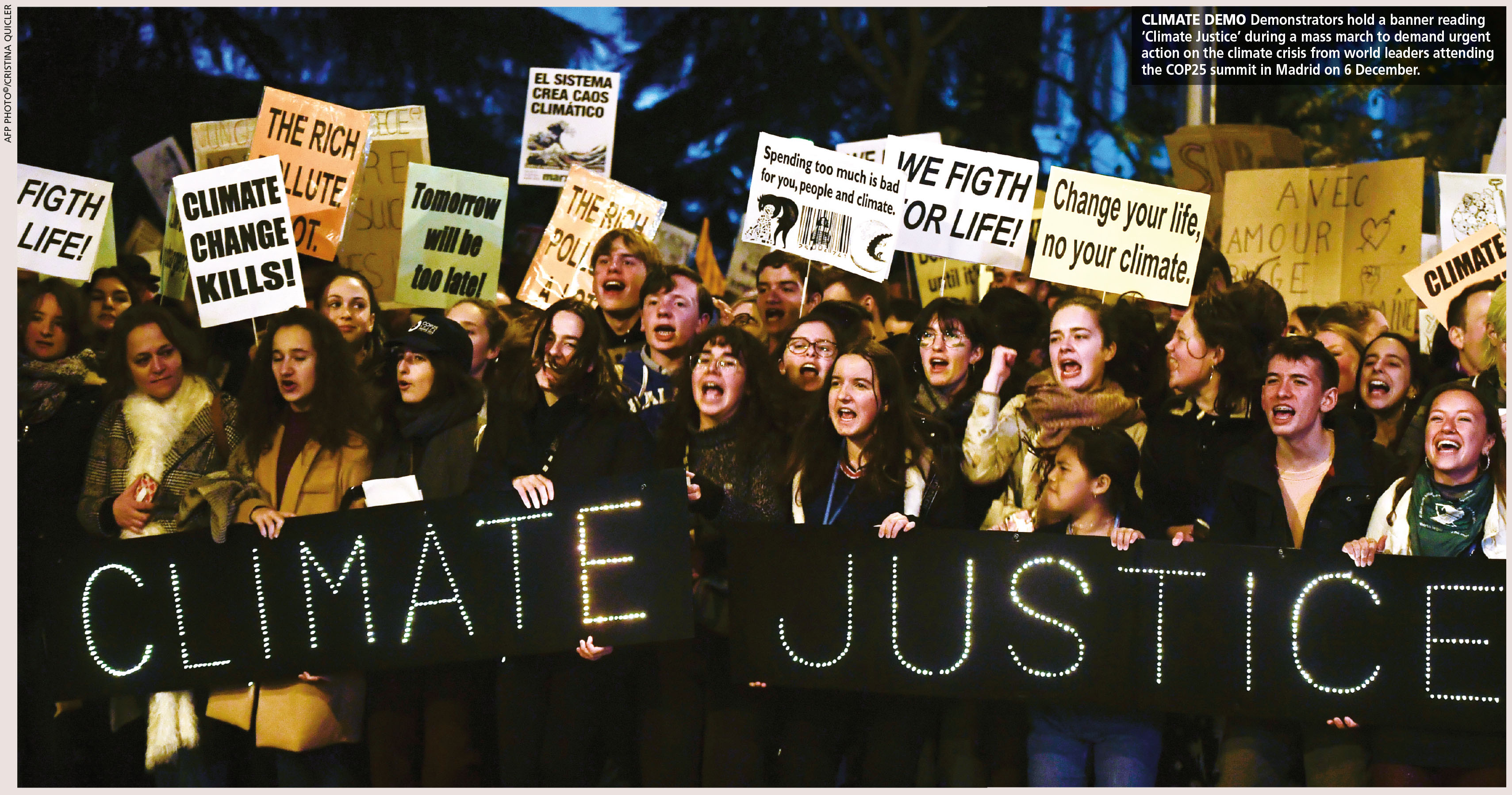COP25 FAILURE
CLIMATE CHANGE DENIAL IS A CRIME
Saro Thiruppathy highlights the numerous issues that stymied the success of COP25 in December – and leaves climate change action up in the air
Once again, the Conference of the Parties (COP25) at the 2019 United Nations Climate Change Conference in Madrid failed to genuinely commit to preventing the Earth’s temperatures from exceeding 1.5°C above preindustrial levels.
This stalemate was engineered by the usual suspects – viz. the US, Australia, Brazil, China, India and others. While a disconnect between the needs of the people and their governments is humongous, the relationship between global polluters and the fossil fuel industry is stronger than ever.
COP25 was originally scheduled to be held in Brazil. But even before climate sceptic Jair Bolsonaro was sworn in as president, he announced that Brazil would not be hosting the conference. And when Chile also pulled out in the wake of social unrest, Spain eventually hosted the summit in December.
The UN Intergovernmental Panel on Climate Change (IPCC) has vividly explained the climate crisis in various reports and the world is very much aware of the urgency to cap greenhouse gas (GHG) emissions. However, there is apparently a deliberate attempt at naivety by the main polluters as they resort to forcefully deny scientific findings.
So once again, the world lost another opportunity in Madrid to make some headway in the fight against rising temperatures. The reasons are varied but the recklessness and irresponsibility shown to future generations is a common thread – it binds detractors and deniers of climate change.
IDENTIFYING RISKS Rising temperatures and GHGs were identified as serious problems in the United Nations Framework Convention on Climate Change, which was adopted in 1992 at the Rio de Janeiro Earth Summit. The Conference of the Parties (COP) process was established when member nations agreed to meet regularly and create rules that would help achieve the goals listed
in the convention.
Regardless of where GHGs are emitted, they mix in the atmosphere and affect the entire planet – unlike other air pollutants, which are mostly localised.
So the less developed countries that reduce emissions end up bearing the cost of doing so while the polluters enjoy the benefits of reduced emissions… free of charge. The governments of polluting countries engage in lucrative relationships with fossil fuel producers and continue to spew GHG into the atmosphere.
At the COP1 meeting in Berlin in 1995, member states decided that some of the richest countries would commit to timebound targets on emission reductions. In 1997, the Kyoto Protocol was adopted and Annex I contained a list of countries and the ‘assigned amount’ of CO2 that each party could emit over a period of time.
But by this time emerging economies such as China, India, Brazil, South Korea, South Africa, Mexico and Indonesia that weren’t listed in Annex I were also beginning to contribute to global emissions through increased industrialisation.
In 2015, COP21 in Paris was hailed as a breakthrough conference when 196 attending parties agreed to the text of the Paris Agreement, which came into force on 4 November 2016. At the core lies the Nationally Determined Contributions (NDCs), which illustrate the commitment by each country to reduce emissions and adapt to the impacts of climate change.
On 1 June 2017, the US (which is the largest emitter of GHGs) withdrew from the Paris Agreement. And since then, nationalistic sentiments around the world have surpassed global responsibility and the biggest polluters are slowly but surely trying to scuttle the process.
FINDING LOOPHOLES One of the main contentions in Madrid was the rules governing the trading of carbon offsets. There is a need to prevent double accounting – by both selling and buying nations – while ensuring an overall reduction in emissions.
A ‘carbon offset’ is a reduction in emissions of CO2 or other GHGs made in order to compensate for emissions generated elsewhere. These offsets are measured in tonnes of CO2 equivalent and sell at between US$ 0.10 and 44 dollars a tonne.
What’s more, the meeting couldn’t agree on whether carbon offsets earned through Kyoto’s Clean Development Mechanism could be transferred to the present day. However, the focus on carbon markets is disproportionate since the mechanism is unable to substantially reduce global warming in the short term.
FAILING THE WORLD Another issue was recognition of the rights of all inhabitants of the most vulnerable countries, and the need to institute social and environmental safeguards for those nations through reparation by polluting countries.
The US, which will exit the Paris Agreement soon, was greatly instrumental in stymieing any progress, and protecting errant governments from liability for loss and damage experienced by countries facing the extreme impacts of climate change.
Eventually, the draft of the final statement from COP25 included more loopholes for polluters rather than the need for augmented ambitions on reducing GHGs.
This failure was best summed up by Ian Fry who represented the low-lying Pacific island state of Tuvalu: “There are millions of people all around the world who are already suffering from the impacts of climate change. Denying this fact could be interpreted by some to be a crime against humanity.”






Leave a comment